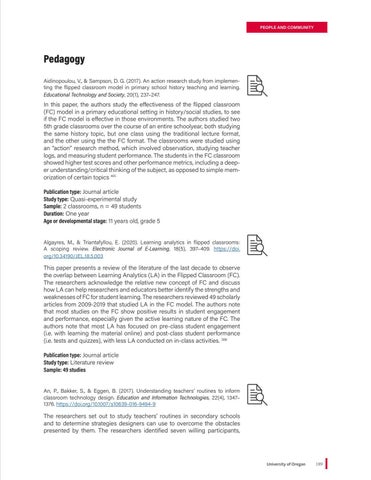PEOPLE AND COMMUNITY
Pedagogy Aidinopoulou, V., & Sampson, D. G. (2017). An action research study from implementing the flipped classroom model in primary school history teaching and learning. Educational Technology and Society, 20(1), 237–247.
In this paper, the authors study the effectiveness of the flipped classroom (FC) model in a primary educational setting in history/social studies, to see if the FC model is effective in those environments. The authors studied two 5th grade classrooms over the course of an entire schoolyear, both studying the same history topic, but one class using the traditional lecture format, and the other using the the FC format. The classrooms were studied using an “action” research method, which involved observation, studying teacher logs, and measuring student performance. The students in the FC classroom showed higher test scores and other performance metrics, including a deeper understanding/critical thinking of the subject, as opposed to simple memorization of certain topics 401. Publication type: Journal article Study type: Quasi-experimental study Sample: 2 classrooms, n = 49 students Duration: One year Age or developmental stage: 11 years old, grade 5 Algayres, M., & Triantafyllou, E. (2020). Learning analytics in flipped classrooms: A scoping review. Electronic Journal of E-Learning, 18(5), 397–409. https://doi. org/10.34190/JEL.18.5.003
This paper presents a review of the literature of the last decade to observe the overlap between Learning Analytics (LA) in the Flipped Classroom (FC). The researchers acknowledge the relative new concept of FC and discuss how LA can help researchers and educators better identify the strengths and weaknesses of FC for student learning. The researchers reviewed 49 scholarly articles from 2009-2019 that studied LA in the FC model. The authors note that most studies on the FC show positive results in student engagement and performance, especially given the active learning nature of the FC. The authors note that most LA has focused on pre-class student engagement (i.e. with learning the material online) and post-class student performance (i.e. tests and quizzes), with less LA conducted on in-class activities. 399 Publication type: Journal article Study type: Literature review Sample: 49 studies An, P., Bakker, S., & Eggen, B. (2017). Understanding teachers’ routines to inform classroom technology design. Education and Information Technologies, 22(4), 1347– 1376. https://doi.org/10.1007/s10639-016-9494-9
The researchers set out to study teachers’ routines in secondary schools and to determine strategies designers can use to overcome the obstacles presented by them. The researchers identified seven willing participants,
University of Oregon
189

